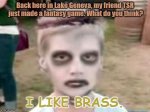I hope RGB (additive) is being taught as the primary colors today, but in the 1970s anyone who didn't work in television or printing definitely thought of RYB (mixing) as the primary colors.
I thought about mentioning that. If you were a bit nerdy in the A/V sense back in the day, you'd've definitely been familiar with 'additive' primaries (and maybe felt a little smug superiority over it), and/or if you'd paid attention to the popular-science level explanations of color TV back in the 60s (color TV was a big deal for a while).
Thanks for bringing up heraldry; surely some of the TSR folks had studied that topic. If the dragons were based on heraldry colors, wouldn't they have included purpure (purple)?
https://en.wikipedia.org/wiki/Subtractive_color#RYB
IDK, I don't recall hearing of purpure (or tunney or anything else but the above, and 'propper' (natural color of the thing, which'd seem highly debateable in the case of dragons), the times I looked up heraldry (card catalog!) in library books back in the day. Today it's on Wikipedia, fwiw. (Plus, the 'purple' of antiquity was prettymuch red.)
The Red Dragon of Whales is a particularly well-known bit of heraldry, and Smaug was depicted as being red by the Brothers Hildebrandt around the same time. Of course the myth of Merlin and the red & white dragons fighting under the castle would've been quite familiar to EGG & co.
I never would have even considered that to be a criteria. I can't remember how many hit points an ogre has off the top of my head, either.
Had 4+1 HD back in the day.
Hill, Stone, Cloud, Frost, Fire, Storm. Why those six?
Fire & frost from Norse mythology, Cloud/Storm for Jack & the Beanstalk. I feel sure Stone Giants - enigmatic giants that blended in with rocky terrain - were ripped off from /something/ - it's teasing at the edges of my poor old memory. Hill giants were a sort of scaled up (70s-misconception-of-a) Neanderthal.
Flesh, Clay, Stone, Iron. Why those four?
Film. The original golem of clay had been featured in film (a classic silent, and a rather crappy color effort in, I think, the 60s, either or both of which Gygax could have seen). The Iron Golem was clearly inspired by Harryhausen's apocryphal take on Talos in Jason & the Argonauts (the artifact section of the DMG, in passing, mentioned Talos as a "triple iron golem"). The Flesh Golem is transparently a Frankenstein's monster. As for Stone, animated stone statues or humanoid stone creatures made it onto the screen mid-centuryish any number of times.
Actually, I'd blame a /lot/ of D&D monsters on old movies.
Nearly all of D&D's early monsters have known obvious precedents in myth & fiction (except for a select batch that were derived from a weird set of plastic toys)
Bullete, Rust Monster, & Owelbear, for sure, ...maybe Umber Hulk & Xorn?
, but not most of the core dragons (red is European myth, gold is Chinese myth, the rest are ???). That's exactly what bugs many of us.
Red is European in the familiar sense of breathing fire, sure, and Red (and green and white and black) dragons appeared in heraldry. The White dragon breathing frost might have come from somewhere, but it appeals to nerd sensibilities, I think, to have a frost antithesis for every fire, too. Not all dragons of European myth breathed fire, though, some were horribly poisonous and/or had corrosive blood, instead. So black & green seem covered, as well. "Breathing lightning" doesn't sound like anything from myth, though. I wouldn't be surprised if the white & blue dragons came from some obscure pulp or fantasy short story or something.
Dragons are literally
the most important monsters in D&D, and their subspecies are filled with WTF. They aren't from
source material. They don't have internal logic. And they don't make the game simpler. Any way I look at it, they should have been designed differently.
I suppose they have some internal consistency, in having breath weapons of the major damage types of the classic game.
You also have to consider the zeitgeist of the 70s. It was an iconoclastic decade, taking something traditional and tweaking it like that - oh, there are fire-breathing dragons? how 'bout cold-breathing ones? how bout ones that breath rainbows or marshmallows?
...oh, and did I mention the psychedelic drugs?




